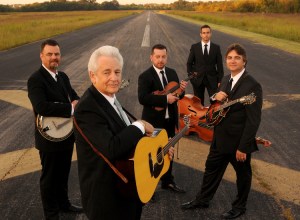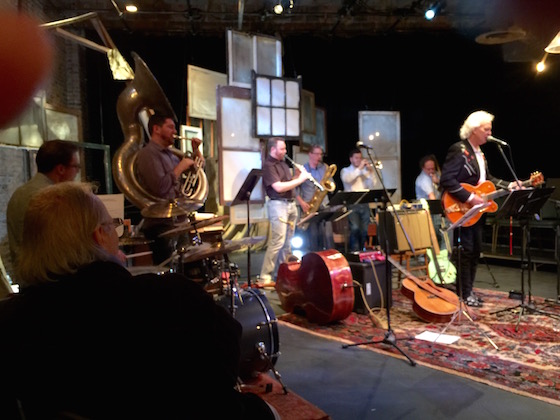Verboten: How Some Evanston Tween Punks Played at the Cubby Bear in 1983
Posted: January 30, 2020 Filed under: Music, Punk rock, Theater Leave a comment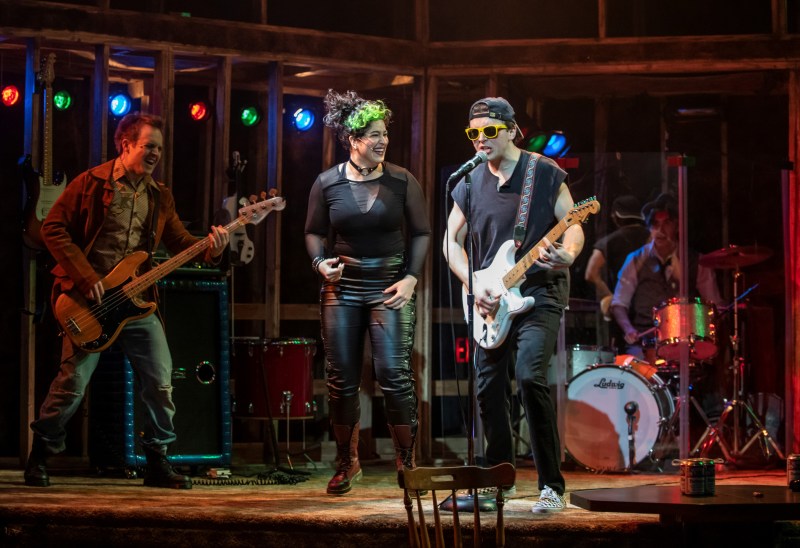
Verböten: Krystal Ortiz and Kieran McCabe at the Cubby Bear. Photo by Michael Brosilow.
The House Theatre of Chicago just opened a new play that I have to recommend to my music-loving friends. It’s Verböten, the story of a kid punk band from Evanston, and how they managed to play a gig at the Cubby Bear in Wrigleyville in 1983. They all had family problems of one kind or another and found another family with their bandmates. Jason Narducy started the band at the age of 11. He and his friends rehearsed in the basement of a friend’s house. A year later, they played at the Cubby Bear–and there’s a grainy old video to prove it.
Narducy wrote music and lyrics for the play with the book by Brett Neveu, a well-known Chicago playwright. Narducy has been a musician ever since, playing with Liz Phair and Telekinesis. Today he plays bass with the Bob Mould Band and SuperChunk and fronts Split Single, a b and that has made two albums with a rotating cast of musicians.
You can see Verböten by House Theatre at Chopin Theatre, 1543 W. Division St., through March 8. Tickets are $30-$50 for performances Thursday-Sunday. Student and industry same-day discounted tickets are $20, for all dates, based on availability.
Here’s my full review of the play at Third Cōoast Review.
Springsteen at 70: A Playlist
Posted: September 26, 2019 Filed under: Music 2 Comments
Springsteen at a 2016 concert. Photo by Brian Rasic/WireImage, courtesy Billboard.
This week was Bruce Springsteen’s 70th birthday and fans all over the world observed it in various creative ways. At Third Coast Review, the place where most of my writing is posted, we curated a special playlist on Spotify. I had help from two friends–June Skinner Sawyers and Brad Paulsen. We chose a long list of tracks that we like. Not necessarily his best or even our favorites. It’s a list of lesser-known songs that we love to hear and thought that casual fans might not be familiar with.
Here’s what I wrote on Third Coast Review.
Bruce Springsteen’s legions of fans worldwide don’t need a reason to play his music. We listen to it every day. At home, while walking, driving, biking or breathing. But his 70th birthday on September 23 is a reason (or an excuse) to introduce non-fans or casual fans to some Springsteen tracks that you probably haven’t heard. We’ve created this mixtape from deep within Springsteen’s oeuvre of 327 songs. You won’t find “Born to Run” or “Dancing in the Dark” on this mixtape. But you will find “Prove It All Night,” “Brilliant Disguise” and “Wreck on the Highway.” If you listen to these lyrics, you’ll perhaps appreciate the man from New Jersey as a storyteller. There’s the man walking thru the factory gates in the rain, the highway patrolman and his outlaw brother, who traded dances with Maria, and even the woman bagging groceries in the supermarket. (Most fans, by the way, hate the latter song, “Queen of the Supermarket.” But I like it, so it’s on this playlist. If you want to check all the lyrics, you can find them here.)
 The tracks are in chronological order, starting with two songs from his first album, Greetings from Asbury Park, recorded in 1972. Three of the tracks are covers of songs by other artists: “Jersey Girl,” written by Tom Waits, “Chimes of Freedom” by Bob Dylan, and “Because the Night,” which Springsteen wrote with Patti Smith.
The tracks are in chronological order, starting with two songs from his first album, Greetings from Asbury Park, recorded in 1972. Three of the tracks are covers of songs by other artists: “Jersey Girl,” written by Tom Waits, “Chimes of Freedom” by Bob Dylan, and “Because the Night,” which Springsteen wrote with Patti Smith.
After you listen to our Spotify playlist, you can wander over to YouTube to see a video of Springsteen performing an acoustic version of his 1984 hit, “Born in the USA.” It’s his most misunderstood song, best known as an arena anthem, but the acoustic version is a better way to tell the story of a disillusioned Vietnam veteran.
Curating this playlist with me are two local Springsteen fans: June Skinner Sawyers, author of several books on Springsteen and other musicians and co-editor of a new Springsteen book; and Brad Paulsen, an architect and Springsteen fan since his teenage years, who gets credit for introducing me, an audio-only Springsteen fan, to live Springsteen concerts 20 years ago. And that’s how I went from being a casual fan to what Springsteen refers to as one of his “obsessives.” And thanks to Julian Ramirez, our music editor, for his contributions to our playlist.
Banjos and Bluegrass Memories
Posted: May 16, 2017 Filed under: Music 3 Comments
I had the pleasure of seeing a fine concert at the Symphony Center last Friday and it took me back to my time working at Kentucky Fried Chicken in Louisville in the 1980s–one of my favorite jobs ever. My main job was handling press relations for the company. Distributing press releases, arranging interviews and handling the many queries that came in from reporters all over the world about our products and stores. But my very favorite part of the job–and probably the most fun I ever had working–was the annual KFC Bluegrass Music Festival.
The first time I wrote about that here was in an essay titled “The Day I Discovered Bluegrass.” I wrote then: “I worked at KFC less than two years but returned to work at the bluegrass festival for several years thereafter. (Unfortunately, the festival didn’t survive the merger of KFC’s parent company with another giant corporation.) The festival was a highlight of my year – spending several days on the riverfront hanging out with music press and musicians, talking to festival attendees, and listening to music, music, music.”
Abigail’s clog dancing reminded me of the many clog dancers who performed at the festivals–earnest young people dressed in their Sunday best and wearing clunky clogging shoes. And I remembered the night that heavy rain shut down the festival and we spent the evening inside the adjacent hotel, drinking beer, listening to music and, yes, clog dancing, or just dancing. Friday night at the Symphony Center brought it all back.
My review of the Friday concert ran today in Third Coast Review. Here it is.
The Symphony Center is a different place when the program veers away from classical. Few suits and ties, no designer dresses or jewelry. Plenty of jeans and khakis, checks and plaids, t-shirts with lettering, a bolo tie or two, boots and hoodies. It’s a different audience vibe when the music is bluegrass. And so it was last Friday when Bela Fleck, the banjo virtuoso, and his multitalented wife, Abigail Washburn (vocals and clawhammer banjo) took the stage for a one-hour set.
They were followed by the Del McCoury band, a traditional bluegrass band made up of guitar, mandolin, banjo, fiddle and upright bass. And all five musicians did wear suits and ties, as traditional bluegrass players do.
When Bela and Abbie came on the CSO stage, they looked around at the beautiful auditorium and Bela said, admiringly, “Looks like this place needs some banjo playing.” And so they did.
Bela Fleck is gray-haired now and a little heavier than when I met him 30-odd years ago at a KFC Bluegrass Music festival in Louisville. He was playing then with a progressive bluegrass band called New Grass Revival, featuring mandolin player Sam Bush. I was doing press relations for KFC corporate, and so I got the bluegrass festival assignment. Three full September days of bluegrass, morning to night, on the riverfront plaza. I worked for KFC for less than two years, but went back several years after that to work at the festival.
Fleck and Washburn released an eponymously titled debut album, which won a 2016 Grammy for Best Folk Album and they’re working on a new album. Fleck is a superbly talented banjo player, focused totally on his instrument. Washburn’s effervescent personality, sassy commentary and song stylings bring energy and charm to their duo act.
Many of the songs they played were their own compositions, but they opened with a traditional folk song, “I’ve Been Working on the Railroad,” with a vocal by Abigail. They performed a song in Chinese, built on Abigail’s many tours to China and her fluency in Mandarin.
Another number performed with great feeling was “Come All Ye Coal Miners,” an eastern Kentucky labor protest song by Sarah Ogan Gunning, from a coal mining family. They also played a Carter Family song, “My Home’s Across the Blue Ridge Mountains.”
Their most powerful performance was on “Harland, Kentucky,” a song they composed together. Abigail, whose vocals started out sweetly and became more robust as the set progressed, announced that she was going to do something during this song that she had never done before. And she accompanied the powerful lyrics with an excellent display of Appalachian clog dancing, her heels providing percussion and punctuation for the lyrics and Bela’s picking.
The pair switched instruments frequently, with Bela occasionally playing a small ukulele banjo as well as a baritone banjo.
At one point, the pair described and demonstrated the differences in their playing styles. Abigail plays clawhammer banjo, sometimes called frailing, a rhythmic strumming style of playing. The banjo and that style of playing were brought from West Africa by the blacks who became slaves in the south.
Bela plays bluegrass banjo, notable for its fast three-finger picking, made famous by Earl Scruggs.
The clawhammer banjo has an open back, while the bluegrass banjo has a resonator back to enhance its sound. But the main difference between the two styles is picking vs strumming.
The Del McCoury Band came on for the second set, led by the bluegrass veteran Del McCoury on guitar and lead vocals. His two sons, Ronnie and Rob, play mandolin and banjo. Jason Carter plays a fabulous fiddle and Alan Bartram is on upright bass. The band performs close harmony on traditional bluegrass songs such as “Kentucky Waltz” and more contemporary tracks such as “Nashville Cats” by John Sebastian of the Lovin’ Spoonful.
The Del McCoury Band has been playing more or less in its current form since 1992. They have won the International Bluegrass Music Association’s Entertainer of the Year award nine times. They record now on their own label—McCoury Music.
A Few Things About 2016 That Didn’t Suck
Posted: December 28, 2016 Filed under: Art & architecture, Books, Chicago, Movies, Music, Theater 2 Commentsw/ HT to @anamariecox on 11/18/16
It’s been six weeks since I’ve written a post for Nancy Bishop’s Journal. 2016 has been the year that sucked in so many ways. I probably would not consider it this dismal were it not for the coup d’état we called an election. We now have the prospect of a leader for four years who is a racist, misogynist, uncurious and uninformed buffoon or “an unformed pliable piece of clay,” as Frank Bruni called him in the New York Times. I am firmly in the “Not My President” camp.
This dreadful year started with the death of David Bowie and brought the loss of so many talented artists and musicians. The death of Leonard Cohen last month was one more cruel blow.
But at least there are these few good things about this rotten year.
The Cubs. I’ve been a Cubs fan since my father taught me how to keep a scorecard when I was 12. He and my late sister were dedicated Cubs fans. I wish they could have been here to enjoy 2016 with us.
Third Coast Review. I’m grateful for all the great contributions from so many writers and editors for our new arts and culture website, launched January 8. Our previous website, Gapers Block, went on hiatus as of January 1. We scrambled to get a new website started so we could continue to write about Chicago arts and culture and now we’re almost at our one-year anniversary. So my thanks to Emma, Kim, Sarah, Miriam and Jeanne for helping us get started and to Zach, Julian, Steve, Marielle, Justin, Stephanie, Colin, Brent, Andrea, Elif, Chris, Louis, James, Karin, and all the other writers who helped us plug the hole left by GB.
Bruce Springsteen’s memoir, Born to Run. A readable, memorable story of his life and music, told in his own voice and not papering over the dark places. Seeing him in concert three times this year—twice in Chicago and once in Louisville—made the year come alive.
Leonard Cohen’s new album, You Want It Darker. Speaking of dark places, this last album by the great poet and songwriter is very dark and moody and a marvelous set of farewell tracks. Similar to the way David Bowie said farewell in his final work, Blackstar, and especially in the song, “Lazarus.”
Two Jim Jarmusch films, Paterson and Gimme Danger. Many great films this year, but these two Jarmusch films are unique. Paterson (release date 12/28) is a small film about a bus driver and poet named Paterson. Not much happens but poetry and love. The city of Paterson, New Jersey, is a character in the film too, as Paterson drives his bus route around the old industrial city. Gimme Danger is Jarmusch’s documentary on Iggy Pop and the Stooges, with Iggy starring as an articulate, reflective older version of himself. While it’s not one of the best films of the year, it’s an interesting doc and shows Jarmusch’s talent and versatility.
My two favorite books of the year were Colson Whitehead’s novel, The Underground Railroad, which really is about a railroad, and Ian McEwan’s novella, Nutshell, told in the voice of a fetus that may turn out to be Hamlet. Through Whitehead’s book, you’ll get a visceral feeling for what slavery was like as well as some elements of history and magical realism. Nutshell is deliciously gossipy, charming and Shakespearean.
Kill Your Darlings, the live lit and improv series, cosponsored by Third Coast Review, was seven weeks of hard work and great fun. I wrote my own story for each of the seven nights of readings, based on the seven cultural categories on Third Coast Review.
The most memorable evening was when I read a poem titled “City Lady Blues,” accompanied by my son Steve on tenor sax. You can listen to the podcast. But I also loved telling my story about the Spanish Civil War in my dreams.
So much art, so little time. Some of my favorite exhibits of the year were at the Art Institute. The current exhibit of work by Laszlo Moholy-Nagy is fabulous in curation and organization and in the way it displays the curiosity and versatility of Moholy. The exhibit of Aaron Siskind’s Abstractions at the Art Institute was also memorable. Van Gogh’s Bedrooms was on the surface a modest exhibit but a brilliant way to illustrate the mind that created the bedroom paintings.
Other fine exhibits were the Strandbeests: The Dream Machines of Theo Jansen at the Chicago Cultural Center and the exhibit of illustrations from Puck, the 19th century magazine of politics and humor at the Driehaus Museum.
Finally, I spent a memorable hour or two at the Art Institute following poet Stuart Dybek around the Modern Wing as he talked about art and poetry and read poems by various poets, including himself, dedicated to some of his favorite paintings.
Nights of great theater. I see 150-200 plays a year, as a reviewer and some as plain audience member. These were some of my favorites from this year, not listed in rank order. I’m going to reprise this list with commentary in a “best of 2016” post at thirdcoastreview.com. (And I did. See our Best of 2016: On Stage in Chicago.)
Direct from Death Row: The Scottsboro Boys at Raven Theatre
Haymarket: The Anarchists’ Songbook at Underscore Theater Company
Life Sucks at Lookingglass Theatre
Man in the Ring at Court Theatre
The Weir, Spinning and In a Little World of Our Own at Irish Theatre of Chicago
2666 at Goodman Theatre
The Flick at Steppenwolf Theatre
American Buffalo at Mary-Arrchie Theatre
The Hairy Ape at Oracle Productions
Music Flicks for a Summer Night: Hank, Miles and Chet
Posted: August 29, 2016 Filed under: Movies, Music | Tags: Born to be Blue, Chet Baker, Hank Williams, Kind of Blue, Miles Davis 1 CommentI’ve been watching music biopics this week. Three of them. They’re stories of individual musicians and each film is flawed yet satisfying in its depiction of some part of a musician’s life and struggle. The films are recent and all available on DVD—or you may be able to find them on a streaming service.
I Saw the Light (2015, 123 minutes)
This is the weakest of the three films in its portrayal of the life and career of the great Hank Williams, who died at the age of 29 after a short but brilliant career beset by addiction to alcohol and drugs. The film is worth seeing for Tom Hiddleston’s portrayal and performances of Hank Williams’ songs. He seems to become Williams physically and his voice is close to the tone and style of the original. (I listened to some original Hank Williams after watching the film and Hiddleston’s voice is more silky smooth than Williams’ voice.) Even so, Hiddleston never gets beneath the surface of what made Williams tick. And neither does the film.
Elizabeth Olsen plays his first wife Audrey, who had delusions of being a country singer herself despite no talent. Cherry Jones has some great scenes as Hank’s mother, Lillie.
My objection to the approach taken by the director Marc Abraham is that it doesn’t show any of Williams’ early musical inspirations in black gospel music or anything about Rufus Payne, the black street musician who taught him to play the guitar. The play Lost Highway staged by American Blues Theater in 2015 and 2016 did a better job of showing Williams’ life and influences and included Rufus “Tee-tot” Payne as one of the characters important in Williams’ life.
So I’m still waiting for a good film about the great Hank Williams. The Last Ride (2012) directed by Harry Thomason was even less satisfying. Henry Thomas plays the Hank Williams character who hires a local kid to drive his own blue Cadillac to his last gigs in late December 1952. That was indeed the last ride; Williams died in the car on New Year’s Day 1953.
And I don’t even want to watch Your Cheatin’ Heart (1964) again. I remember it as dreadful. Directed by Gene Nelson, it features George Hamilton lip-synching (badly) as Williams.
Miles Ahead (2015, 100 minutes)
Another film about a great musician, Miles Ahead also takes a segment of that life. The film portrays trumpeter Miles Davis during the five-year stretch that he took off from playing or composing. Don Cheadle is the best part of this film. He wrote, directed and plays Davis, very believably. Cheadle bears some slight resemblance to Davis (as Hiddleston does to Williams) so that helps. The late 1970s scenes are intercut with earlier scenes when Davis was performing with his band in the top jazz clubs around the world and celebrated as a brilliant performer. His first wife, Frances Taylor, is beautifully played by Emayatzy Corinealdi, a dancer who gives up her career for Davis.
The plot suggests some events that happened or might have happened in Davis’ life and uses the plot device of a Rolling Stone reporter (Ewan McGregor) who is trying to write a profile of Davis. (Echoes of End of the Tour, about a reporter’s relationship with David Foster Wallace, among other films.) There’s also a storyline about Davis trying to get back the session tapes he believes he owns from his recording company.
Some famous and talented musicians play members of Davis’ band. Herbie Hancock, Wayne Shorter, Gary Clark Jr. and Esperanza Spalding add a lot to the musical performance scenes. Cheadle did learn to play the trumpet for the film but the music we hear is usually the trumpet work of contemporary jazz trumpeter Keyon Harrold who recorded over Cheadle’s playing. The rest of the trumpet work is that of Miles Davis himself, pulled from old recordings.
Some of the plot devices—like fist fights and a car chase punctuated with shooting—just seem silly and don’t add to the film’s quality.
After I watched Miles Ahead, I got out my Miles CDs and listened to Kind of Blue and Sketches of Spain, my two personal jazz favorites.
Born to be Blue (2016, 97 minutes)
Another film about a jazz trumpeter—Chet Baker—features a really fine performance by Ethan Hawke as the troubled musician. I think this is the best of the three music films I’m reviewing here.
The story, directed by Robert Budreau, is a “reimagining” of the musician’s life in mid-career. Baker, a white West Coast musician who played the cool West Coast style jazz of the ‘50s and ‘60s, wanted to play at Birdland in New York and be accepted by the black jazz musicians of the bebop and cool genre. (At one point, Miles Davis tells him “Come back after you’ve done some livin’.”) He does eventually play at Birdland but the story is primarily about his battle with heroin and recovery from a brutal attack (possibly by a drug dealer) that severely cut his lips, knocked out his front teeth and ruined his embouchure. He wasn’t able to play the trumpet comfortably for months.
Like Don Cheadle in Miles Ahead, Hawke learned to play the trumpet for his role—so he could look like he knew how to play the trumpet. The music he plays was recorded by another musician—Kevin Turcotte. Baker also often sang in concert and on his albums—in a wispy, reedy soft voice—and Hawke does the vocals himself in a couple of scenes.
Carmen Ejogo is terrific as Jane, sort of an amalgam of the various women in Baker’s live over the years. There’s a real chemistry between them and the interracial relationship works. There’s a film within a film story going on but the main plotline is about Baker’s recovery from the attack, and his efforts to stay off heroin and thus out of jail.
Ultimately (and here’s a spoiler), he decides he loves heroin and the way it allows him to play too much to give it up. At one point, he explains to his manager (Callum Rennie) why. “It gives me confidence,” he explains. “Time gets wider, not just longer, and I can get inside every note.”
Baker spent most of the last decades of his life in Europe as a musician and heroin addict. He died at 58 in Amsterdam in 1988.
Bingeing on Hamilton: Words and music
Posted: March 25, 2016 Filed under: Books, Music, Theater Leave a comment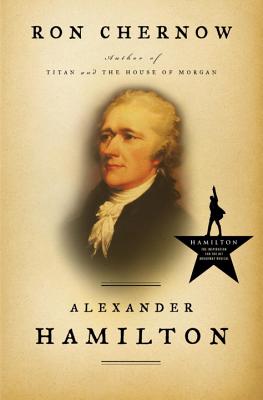 Huge sigh of relief. I finally finished the 800+ page biography of Alexander Hamilton by Ron Chernow. It’s the book that Lin-Manuel Miranda took on a beach vacation to Mexico. It inspired him, first of all, to write a song about our first Treasury secretary and perform it at the White House, and second, to create the Broadway extravaganza known as Hamilton: An American Musical.
Huge sigh of relief. I finally finished the 800+ page biography of Alexander Hamilton by Ron Chernow. It’s the book that Lin-Manuel Miranda took on a beach vacation to Mexico. It inspired him, first of all, to write a song about our first Treasury secretary and perform it at the White House, and second, to create the Broadway extravaganza known as Hamilton: An American Musical.
In my original review of Hamilton, I predicted that Miranda would be named a MacArthur Fellow (better known as the MacArthur Genius Grant) and he was. Predicting that Hamilton will sweep the Tonys in June isn’t a very big bet.
I saw Hamilton when it opened on Broadway last September and fell madly in love with the show, with Miranda and with our ten-dollar Founding Father. Evidence of my madness?
- I’ve been listening to the cast album almost daily since it was released. I’m waiting impatiently for the script to be released.
- I’m looking forward to seeing Hamilton again, surely more than once, when it opens here in September. (At the dreadful Shubert/LaSalleBank/BankofAmerica/Private Bank Theatre.)
- I find myself hoarding $10 bills.
- I don’t want to hear about replacing A. Hamilton on the tenner. Replace that unsavory president Jackson on the $20 with a deserving female figure.
- His birthday and death date are six months apart on the 11th of January and July. They’re both in my calendar.
I have a pretty good background in American history and political science, but when I saw and thought more about Hamilton, I realized that I had been living with the Jeffersonian concept of American government. Journalism students (Mizzou J-School grad here) are educated to admire Jefferson in particular because of his views of the importance of press freedom and freedom of expression, and his role in drafting the Declaration of Independence and the Constitution. I knew he owned slaves and I knew about the Sally Hemings thing, etc., but never mind. Reading the Hamilton/Federalist Party side of the story, you learn that Jefferson was a vicious opponent of Hamilton’s goals and fought for the agrarian way of life he preferred rather than the urban/mercantilist/manifacturing society that Hamilton fought for. (As an aside, Daveed Diggs is terrific as Jefferson in the Broadway cast.)
Reading Alexander Hamilton gave me a different perspective on American history and the founding decades of our country. Ron Chernow’s book, by the way, is highly readable and fascinating. If it wasn’t, I wouldn’t have read every last word and even devoured the 100 pages of notes. And Miranda’s hiphop operetta does not skimp on the details of Hamilton’s life, his brilliance and his foibles, and the controversies surrounding him. It is a full and complete lesson in American history, delivered with charm and infectious rhythm. The thing about hiphop that makes it work, Miranda says, is that it’s very dense, has more words per measure than most other forms of music. (Sort of Dylan and early Springsteen.)
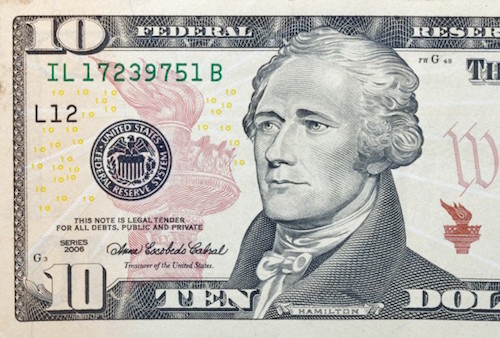
Here are a few reasons why I’m a fangirl of A-dot-Hamilton.
- Hamilton is the avatar of the cliché known as the American dream; he rose from poverty and orphanhood to become an accomplished and powerful leader. Unlike most of the other Founding Fathers, he did not come from the moneyed, landed class.
He was born on a small island in the Caribbean, of unmarried parents, an absent father and a mother of questionable virtue. He came to the US as a teenager and made his way through college (Kings College, now Columbia University), to George Washington’s staff, to leadership on the battlefield in the Revolutionary War, and to Washington’s cabinet.
2. He produced all kinds of firsts in the early era of this country (despite opposition at every step of the way).
He was the first Secretary of the Treasury, stabilized the economy, designed our financial system, including the National Bank, the gold-based dollar, and the Mint; he established the principle that Congress had the constitutional powers to issue currency, regulate interstate commerce, tax luxury goods such as whiskey, and enact any other laws needed to support the provisions of the Constitution.
Basically, he fought for the concept and principles of the federal government. He created the Coast Guard, the Federalist Party and its newspaper, the New York Post. He used his incredible energy and persuasive abilities to work for the passage of the US Constitution, ensuring our country became a federal government, instead of a bunch of independent states. He was firm in his abolitionist views while his southern colleagues all owned slaves.
3. He was a brilliant thinker, speaker, opinionated and prolific writer, who turned out hundreds of letters, opinion pieces and essays and wrote 51 of the 85 articles in the Federalist Papers. And he was writing by hand with a quill pen and a bottle of ink, my friends. In case you think tapping a few tweets on your smartphone is work.
He often wrote political essays under pen names such as Cato, Publius and Phocion. He was probably the first blogger. (His handle today? @publiusny.)
He founded the New York Post, a Federalist newspaper, in the days when political parties specialized in publishing diatribes against the opposition in their own newspapers.
- Jefferson and Madison and their Republican party fought Hamilton and the Federalists at every step and President Adams banished him from the White House because he suspected him of conspiring with some of Adams’ cabinet officers. (He probably was.)
Chernow’s description of the bitterly fought election of 1800, by the way, is insightful to read and compare with the 2016 campaign. And they didn’t even have Twitter.
By the time Hamilton reached his late 40s, he was no longer a public persona (and he missed the limelight) but was a successful and sought-after lawyer in New York.
He had always had a tenuous relationship with Aaron Burr (who advised him, according to Miranda, to “speak less and smile more”), even though they occasionally appeared to be on friendly terms. Hamilton said negative things about Burr in private on a few occasions and these eventually brought Burr to challenge him to a duel. (An affair of honor, it was called. “Demanding satisfaction” was another way to put it.)
Hamilton, at age 49, was killed by Burr in the duel on July 11, 1804, in the dueling grounds at Weehawken, New Jersey. (The same place where Hamilton’s son Philip was killed in a duel three years earlier, upholding his father’s honor.) Burr shot directly at Hamilton and Hamilton either shot in the air or his gun went off by accident when Burr’s bullet hit Hamilton in the hip, destroying his internal organs.
“I’m not throwing away my shot,” Hamilton sings early in Act 1. “But yo, I’m just like my country / I’m young, scrappy and hungry / and I’m not throwing away my shot.” At the end, he did.
I’m not the only one who is bingeing on Hamilton. There’s new interest in historical sites such as the Grange, the Hamilton home north of Manhattan, and in the Hamilton burial site at Trinity Church in lower Manhattan.
Charlie Rose has featured members of the Hamilton crew several times, including this recent full-hour interview with Lin-Manuel Miranda filmed at his childhood home.
Finally, since March is Women’s History Month, I’ll close by noting that Hamilton’s exemplary wife, Eliza Schuyler Hamilton, who stuck with him through all his battles and infidelities, lived 50 years after her husband’s death and died at age 97 in 1854. She worked for causes such as the establishment of orphanages and helped her friend Dolley Madison raise funds to construct the Washington Monument. She visited the White House and never gave up trying to salvage her husband’s reputation, which was attacked by his enemies after his death. Chernow devotes the first and last chapters of his book to Eliza Hamilton.
In 2009, Miranda performed the lead song about Hamilton at the White House. He said at the time he was working on a Hamilton “concept album.”
The Super Bowl Magic Show: Beyoncé, Coldplay & Bruno Mars
Posted: February 10, 2016 Filed under: Music, TV, radio | Tags: beyonce, bruno mars, coldplay, super bowl halftime show 2 CommentsI haven’t paid attention to football since 1986 when the Bears won the Super Bowl. Best team, best Super Bowl ever! I like basketball, baseball and sometimes hockey, but football is a snore. But I do watch the Super Bowl or at least part of it. I might tune in to watch the commercial breaks but my favorite part is halftime.
Because the Super Bowl halftime show is all that counts. It’s amazing how much can be packed into 12 minutes of prime time. Most musicians play a set of their greatest hits (yes, you, Mr Springsteen, in 2009). The Stones in 2006 were memorable and so were the Who in 2010. The Black-Eyed Peas and Usher in 2011 put on a visually stunning show. But the 2016 halftime show was 12 minutes of satisfying drama. Chris Martin started with the 2008 Coldplay hit, “Viva La Vida,” and then segued into “Paradise” and “Adventure of a Lifetime.” The visual effects and background performers were colorful and hundreds of fans in black were packed into the sections around the stage as if they were in the pit at a rock concert. Bruno Mars did a snappy version of “Uptown Funk,” choreographed with his slick and fancy footwork.
And then Beyoncé arrived to steal the show. In black leather, surrounded by her troupe of beautiful African-American dancers. They put on a superb and powerful performance, dressed in black leather shorts and jackets. boots and black berets, paying homage to the 50th anniversary of the Black Panthers, to Black Lives Matter and to black womanhood. Their dance routine at one point formed an X in honor of Malcolm X. It was a highly charged political and sexual performance of Beyoncé’s new song, “Formation.” And it’s probably a good thing that most of the audience couldn’t understand all the lyrics.
The music video of the song was released Saturday and adds even more political context with images of the Katrina flood that drowned New Orleans, Mardi Gras scenes and celebrations of hot sauce, entrepreneurship (“I just might be a Bill Gates in the making”), black beauty and black womanhood.
I’m not going to pretend that I can appreciate all the lyrics and messages because I’m a white female, privileged at that. But I cheer for Beyoncé’s action in putting her fame, power, wealth and glamour behind these messages. She could just sit back and increase her wealth with music and concert revenue, but she puts her image and reputation on the line.
Her video of “Formation” comes in two versions: “Dirty” and “Clean.” I’ll leave you with the best one.
David Bowie Isn’t: My homage to Ziggy Stardust
Posted: January 11, 2016 Filed under: Music, Uncategorized | Tags: David Bowie 1 CommentToday is a sad day. On Friday I listened most of the day to WXRT playing David Bowie’s new album, Blackstar, released on his 69th birthday. Today I was thinking about getting up when the radio went on with the news that the Thin White Duke died last night. I was stunned.
I put on my Aladdin Sane earrings and got out my David Bowie albums. And I remembered the fabulous exhibit of Bowie’s life and work at the Museum of Contemporary Art in September 2014. The title was “David Bowie Is.”

My headline was “David Bowie Is” Is Fabulous. My full review of the exhibit appeared in Gapers Block.
I wrote about how Bowie was a master of design and identity and controlled every aspect of his preparation and performance. And I noted that “David Bowie Is is not just an exhibit for fans of his music or for fans of rock and roll. It’s an exploration of history and popular culture transmuted through the vision of one artist, who probably deserves to be called a genius.”
What I didn’t mention is a key point about Bowie’s persona that is getting a lot of attention today (at least among those I hang around with on social media). He was a man of shifting identities and personas who made it possible for young people to recognize and come to terms with their roles as outsiders, others, maybe even freaks.
Ann Powers of NPR Music wrote this in her appreciation of her pop hero: “His fans were the strange, and Bowie had finally given them a way to show it. The press called them Bowie boys and Bowie girls because there was no other name for them yet: no pansexual, no bi-curious; yes freak, but that felt like a hippie term and this wasn’t a hippie thing.”
My friend June Skinner Sawyers wrote a lovely poem this morning and we’ve posted it on Third Coast Review, the new Chicago arts and culture website, as our homage to Bowie. You can read it here.
2015: Not Quite a Year in Review
Posted: January 3, 2016 Filed under: Digital life, Movies, Music, Theater | Tags: Chicago Architecture Biennial, Gapers Block, Third Coast Review Leave a commentThe last year had many exciting and interesting moments for me, but the last month has been challenging. I spent most of it mourning about and planning how to recover from the demise of Gapers Block, the website for which I’ve written for almost three years. The site is now “on hiatus.” Andrew Huff, the editor and publisher of the 12-year-old website, posted a letter to readers explaining the change. And this is how the site looks now.
Many articles, comments and personal memories have come in to praise Gapers Block but no one has stepped in with the offer of the needed money to update the infrastructure and pay a full-time editor/publisher at least a pittance of a salary. So the site will live on as an archive, with all the existing content live, but nothing new. I couldn’t resist adding my own personal thoughts to the site, which I did late on New Year’s Eve, while waiting for the #ChicagoRising star to rise. (I can’t bring myself to call it “Chi-Town.” No real Chicagoan would use that term.)
GB staff members had known about this for several weeks and after we got over our initial distress, some of us began planning a new website to cover the Gapers Block arts and culture content. The result will be our new website, Third Coast Review, which is online now in an unofficial or “beta” way. We expect it to be official in a week or 10 days once we add more content.
What else was new and important in 2015?
My week in Cuba was memorable and I wrote about it at length here and here.
On another shorter trip, I spent time in New York and was lucky to get a ticket to see the smash Broadway hiphopera (as one of my fellow theater critics calls it), Hamilton, about our first treasury secretary. I wrote about that here and probably will keep writing about it. I intended to see it again later in the year but by then tickets were really impossible to get without paying a couple of months’ salary. And now Hamilton is coming to Chicago in September and will be here (at the dreadful Shubert Theatre on Monroe Street, renamed after yet another bank), so I will be able to see it a few more times.
In the meantime, I’m finally reading the insightful biography that inspired Lin-Manuel Miranda to write the show about our “ten-dollar founding father.” Ron Chernow’s Alexander Hamilton is a fascinating, meticulously detailed and readable biography. I just wish it wasn’t 800 pages long.
The Phantom Collective, the pub theater group formed by my friend June Skinner Sawyers, staged several interesting literary events in 2015, including Black Dogs and Melancholy, a reading of Samuel Johnson writings. The most recent pub event was Beowulf & Grendel, which combined Beowulf, the Old English epic poem, with Grendel, one of Beowulf’s antagonists (dramatized in John Gardner’s 1971 novel,Grendel, in which that character tells his side of the story).
Architecture: We love our buildings. The Chicago Architecture Biennial was a series of exhibits and events from October through today. The most comprehensive was the takeover of the Chicago Cultural Center by about 80 exhibits on four floors by firms and designers that asked questions about and predicted the future of architecture. I particularly liked the architectonic window treatments on the Michigan Avenue facade of the building by Norman Kelley. He clad each window in white vinyl cutouts representing Chicago window styles, mullions and dressings. The biennial as a whole was less than impressive but it was an excellent start and a learning experience for the next biennial in 2017.
Getting ready for Springsteen
Yes, I have the hardly-waits already for the January 19 concert at the United Center featuring my favorite rocker, Bruce Springsteen and the E Street Band. And for the concert February 21 in Louisville, an excuse to visit with my friends Jeannie and John. There will be more. Springsteen is touring on the re-release of his 1980 album, The River, in the form of a large boxed set titled The Ties That Bind. No, I haven’t bought it yet.
The year in review? Not yet.
I usually begin the new year with a list of my favorite events in pop culture for the previous year. I may still do that. For now, WordPress has created my year in review:
The WordPress.com stats helper monkeys prepared a 2015 annual report for this blog.
Here’s an excerpt:
A New York City subway train holds 1,200 people. This blog was viewed about 4,700 times in 2015. If it were a NYC subway train, it would take about 4 trips to carry that many people.
Click here to see the complete report.
Celebrating the life and music of Joe Hill, executed 100 years ago
Posted: December 2, 2015 Filed under: Chicago, Music, Politics | Tags: Big Shoulders Brass Band, Bucky Halker, Filament Theatre, Jon Langford, Pocket Guide to Hell, Sally Timms, The HIdeout Leave a commentSongwriter and labor activist Joe Hill was executed in Salt Lake City on November 19, 1915, framed for a crime he didn’t commit. Because he didn’t “want to be found dead in Utah,” his body was transported to Chicago by the IWW (the Industrial Workers of the World or Wobblies). His last will included the famous entreaty, “Don’t Mourn But Organize.”
Some 30,000 people viewed the funeral procession and attended the lively funeral service at the West Side auditorium (Racine and Harrison) on that November 25 (Thanksgiving Day) and his body was cremated at Graceland Cemetery. What happened to his ashes? That’s another whole story.
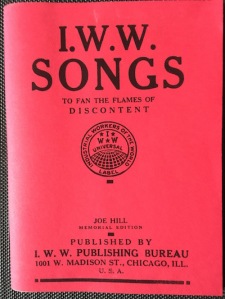 Chicago fans of Joe Hill, a Swedish-born itinerant laborer, celebrated the anniversary of his life and music on several occasions in November. I attended two excellent events, highlighted by great performances of Joe’s music. He wrote dozens of songs that lambasted capitalism and bosses, but his most famous lyric was “You’ll get pie in the sky when you die.”
Chicago fans of Joe Hill, a Swedish-born itinerant laborer, celebrated the anniversary of his life and music on several occasions in November. I attended two excellent events, highlighted by great performances of Joe’s music. He wrote dozens of songs that lambasted capitalism and bosses, but his most famous lyric was “You’ll get pie in the sky when you die.”
The Hideout, a 19th century working men’s saloon on Wabansia, was standing room only the night of the main Joe Hill celebration. My Gapers Block story describes the agenda and list of speakers, which included a funeral oration by Larry Spivack of the Illinois Labor History Society and a rousing description of today’s IWW by Alison Olhava and Randall Jamrok. (The IWW is organizing successfully today, with branches at companies like Jimmy John’s, Starbucks and Pizza Hut. See their website for other industries and companies where the union is active.)
The evening started with a rousing set including “The Preacher and the Slave” by Bucky Halker and his amazing guitar, and closed with songs by a group including Jon Langford and Sally Timms of the Mekons and Martin Billheimer on accordion. Their closing number was “Workers of the World Awaken,” in which the crowd joined in. Psalm One and Fluffy performed a terrific hiphop version of Hill’s “Rebel Girl.”
A funeral march and procession closed the evening and Joe Hill’s coffin was carried outside by pallbearers and burned over a bonfire. The ashes were our burned notes describing why we believe Joe Hill lives today. Anyone who wanted to replicate the 1915 distribution of ashes had only to leave a self-addressed envelope. (In 1915, Joe’s ashes were divided up into a bunch of small envelopes with his picture on the front with the caption, “Murdered by the capitalist class.” The envelopes were given to IWW delegates and guests so Joe’s ashes could be scattered in every state except Utah and in other countries too.)
Bucky Halker, a singer-songwriter and PhD in labor history from the University of Minnesota, just released his new album, Anywhere But Utah: The Songs of Joe Hill, at an album release party at the Filament Theatre in the Six Corners neighborhood. Bucky played with the Big Shoulders Brass Band, featuring two saxophones, trumpet, tuba, trombone and drums. John Abbey sat in on upright bass on several numbers. Bucky and the band played two sets, including “Scissor Bill,” and concluded with a procession around the theater.
Here’s Bucky performing the Joe Hill song from the Little Red Song Book of IWW Songs.
